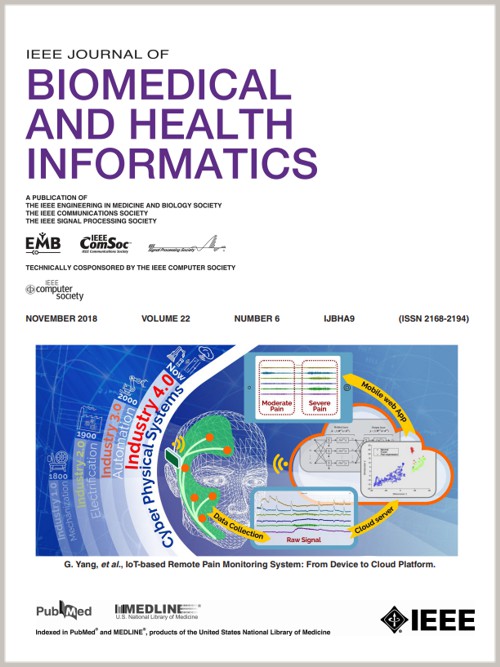Interpretable Multi-Branch Architecture for Spatiotemporal Neural Networks and Its Application in Seizure Prediction
IF 6.7
2区 医学
Q1 COMPUTER SCIENCE, INFORMATION SYSTEMS
IEEE Journal of Biomedical and Health Informatics
Pub Date : 2024-10-15
DOI:10.1109/JBHI.2024.3481005
引用次数: 0
Abstract
Currently, spatiotemporal convolutional neural networks (CNNs) for electroencephalogram (EEG) signals have emerged as promising tools for seizure prediction (SP), which explore the spatiotemporal biomarkers in an epileptic brain. Generally, these CNNs capture spatiotemporal features at single spectral resolution. However, epileptiform EEG signals contain irregular neural oscillations of different frequencies in different brain regions. Therefore, it may be underperforming and uninterpretable for the CNNs without capturing complex spectral properties sufficiently. This study proposed a novel interpretable multi-branch architecture for spatiotemporal CNNs, namely MultiSincNet. On the one hand, the MultiSincNet could directly show the frequency boundaries using the interpretable sinc-convolution layers. On the other hand, it could extract and integrate multiple spatiotemporal features across varying spectral resolutions using parallel branches. Moreover, we also constructed a post-hoc explanation technique for multi-branch CNNs, using the first- order Taylor expansion and chain rule based on the multivariate composite function, which demonstrates the crucial spatiotemporal features learned by the proposed multi-branch spatiotemporal CNN. When combined with the optimal MultiSincNet, ShallowConvNet, DeepConvNet, and EEGWaveNet had significantly improved the subject-specific performance on most metrics. Specifically, the optimal MultiSincNet significantly increased the average accuracy, sensitivity, specificity, binary F1-score, weighted F1-score, and AUC of EEGWaveNet by about 7%, 8%, 7%, 8%, 7%, and 7%, respectively. Besides, the visualization results showed that the optimal model mainly extracts the spectral energy difference from the high gamma band focalized to specific spatial areas as the dominant spatiotemporal EEG feature.时空神经网络的可解释多分支架构及其在癫痫发作预测中的应用
目前,用于脑电图(EEG)信号的时空卷积神经网络(CNN)已成为癫痫发作预测(SP)的有前途的工具,它可以探索癫痫患者大脑中的时空生物标记。一般来说,这些 CNN 可捕捉单频谱分辨率的时空特征。然而,痫样脑电图信号包含不同脑区不同频率的不规则神经振荡。因此,如果不能充分捕捉复杂的频谱特性,CNN 可能会表现不佳且无法解读。本研究为时空 CNN 提出了一种新颖的可解释多分支架构,即 MultiSincNet。一方面,MultiSincNet 可以利用可解释 sinc-convolution 层直接显示频率边界。另一方面,它可以利用并行分支提取和整合不同光谱分辨率的多个时空特征。此外,我们还利用基于多变量复合函数的一阶泰勒扩展和链式规则,构建了多分支 CNN 的事后解释技术,从而展示了所提出的多分支时空 CNN 所学习到的关键时空特征。当与最优 MultiSincNet 结合使用时,ShallowConvNet、DeepConvNet 和 EEGWaveNet 在大多数指标上都显著提高了特定对象的性能。具体来说,最优 MultiSincNet 使 EEGWaveNet 的平均准确率、灵敏度、特异性、二值 F1-score、加权 F1-score 和 AUC 分别大幅提高了约 7%、8%、7%、8%、7% 和 7%。此外,可视化结果表明,最佳模型主要提取了聚焦于特定空间区域的高伽马频带的频谱能量差作为主要的脑电图时空特征。
本文章由计算机程序翻译,如有差异,请以英文原文为准。
求助全文
约1分钟内获得全文
求助全文
来源期刊

IEEE Journal of Biomedical and Health Informatics
COMPUTER SCIENCE, INFORMATION SYSTEMS-COMPUTER SCIENCE, INTERDISCIPLINARY APPLICATIONS
CiteScore
13.60
自引率
6.50%
发文量
1151
期刊介绍:
IEEE Journal of Biomedical and Health Informatics publishes original papers presenting recent advances where information and communication technologies intersect with health, healthcare, life sciences, and biomedicine. Topics include acquisition, transmission, storage, retrieval, management, and analysis of biomedical and health information. The journal covers applications of information technologies in healthcare, patient monitoring, preventive care, early disease diagnosis, therapy discovery, and personalized treatment protocols. It explores electronic medical and health records, clinical information systems, decision support systems, medical and biological imaging informatics, wearable systems, body area/sensor networks, and more. Integration-related topics like interoperability, evidence-based medicine, and secure patient data are also addressed.
 求助内容:
求助内容: 应助结果提醒方式:
应助结果提醒方式:


